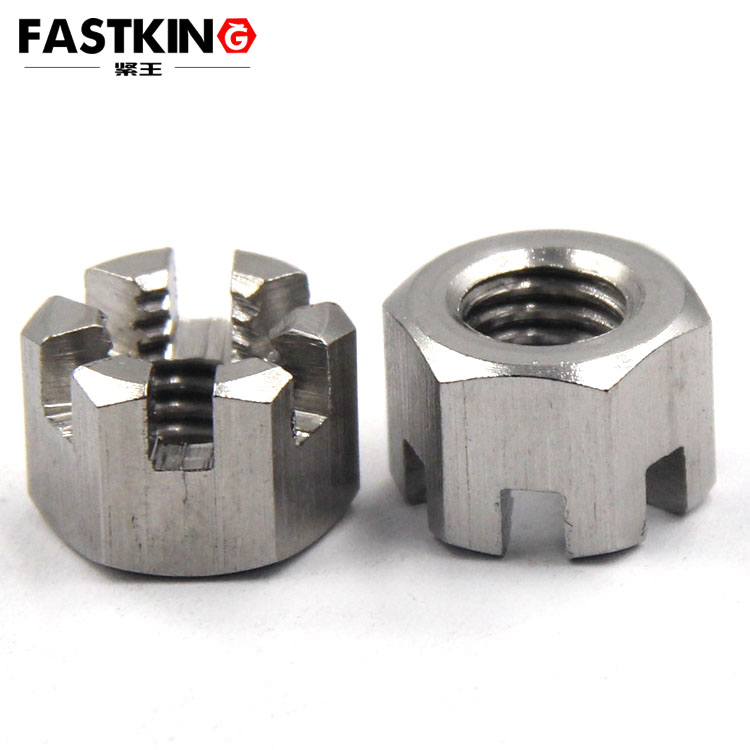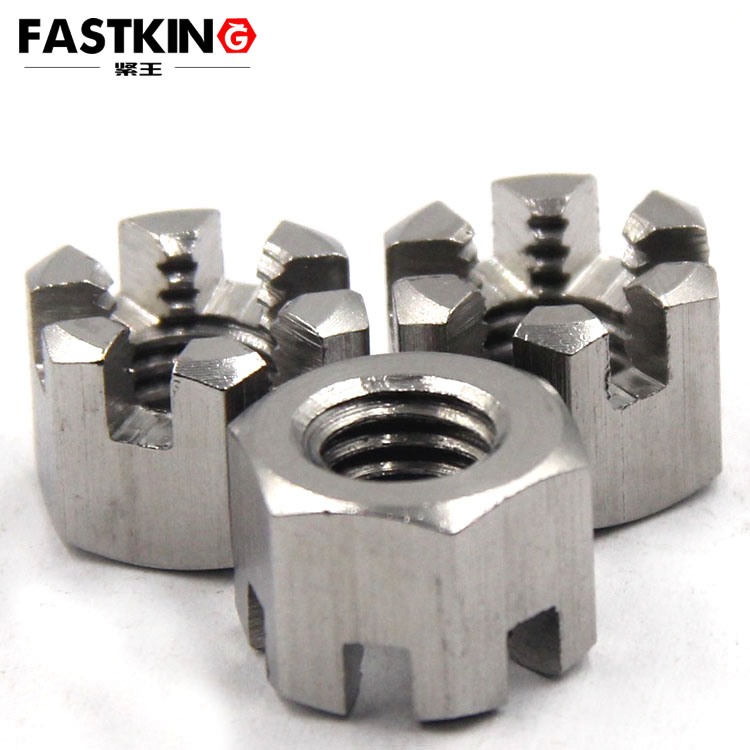Type 1 hex slotted nuts are specially designed fasteners that comply with the Chinese national standard GB/T 6178. Their distinctive feature is the addition of one or more axial slots to a standard hex nut, typically used for inserting cotter pins or retaining rings to prevent loosening under vibration. This design combines the convenient installation of hex nuts with the anti-loosening characteristics of slotted design, giving it unique advantages in mechanical connections requiring high reliability.
Structurally, Type 1 hex slotted nuts maintain the basic shape of standard hex nuts for easy operation with common wrenches. The slots are usually located at the top of the nut, running through its entire height, with varying widths and depths depending on specifications. Common materials include carbon steel, stainless steel, and alloy steel, with surface treatments such as zinc plating, blackening, and chrome plating to meet anti-corrosion requirements in different environments.
Main Application Scenarios of Type 1 Hex Slotted Nuts
1. Aerospace Industry
In aerospace applications, Type 1 hex slotted nuts are critical fasteners. They are commonly used in aircraft engines, wing structures, and landing gear systems because they effectively resist loosening caused by extreme temperature changes and strong vibrations at high altitudes. For example, at the connection points between aircraft skin and framework, slotted nuts with cotter pins ensure connections remain secure under prolonged vibration, guaranteeing flight safety.
2. Automotive Manufacturing and Rail Transportation
Type 1 hex slotted nuts are widely used in automotive chassis, transmission systems, and the bogies of high-speed trains and subways. Key positions like the connecting points of suspension system links and transmission fixing bolts benefit from these anti-loosening nuts, significantly reducing fastener loosening caused by road bumps. In rail transportation, prolonged vibration from train operation easily loosens standard nuts, but slotted nuts with pins greatly improve connection reliability.
3. Heavy Machinery Equipment
Construction machinery such as excavators, cranes, and mining equipment operate in harsh environments with strong vibrations, where Type 1 hex slotted nuts play an irreplaceable role. For example, at the connection points between excavator arms and sticks, or the fixing bolts of crane slewing bearings, slotted nuts effectively prevent connection failures caused by long-term vibration, extending equipment service life.
4. Military and Marine Equipment
Military vehicles and shipboard equipment face extreme conditions on battlefields or at sea, requiring exceptionally reliable fasteners. Type 1 hex slotted nuts are widely used in tank track systems and ship deck equipment fixation. Their anti-loosening characteristics ensure weapons and equipment maintain good performance in harsh environments. Naval vessel equipment fixation particularly relies on this anti-loosening design to resist salt spray corrosion and continuous vibration in marine environments.

5. Power Facilities and Communication Towers
High-voltage transmission towers, wind turbine towers, and communication base station towers often use Type 1 hex slotted nuts. These structures are exposed to wind and rain for long periods, enduring vibration from wind loads. Slotted nuts with cotter pins ensure connection points remain secure for ten years or longer without loosening. Especially at the connection between wind turbine nacelles and towers, these nuts significantly reduce maintenance needs.
Correct Usage Methods for Type 1 Hex Slotted Nuts
1. Pre-Installation Preparation
Selecting the appropriate nut specifications is crucial. Ensure the nut matches the bolt thread (e.g., M6, M8) and that the slot width matches the cotter pin or retaining ring to be used. Before installation, check for thread damage and remove any debris or grease from the bolt and nut threads. For critical connections, use a torque wrench to ensure accurate preload.
2. Step-by-Step Installation Guide
First, screw the nut onto the bolt to the specified position and tighten it with a torque wrench according to design requirements. For connections requiring preload, tighten in stages—typically to 50% torque first, then 80%, and finally 100%. After tightening, align the slot with the bolt's pin hole. Insert the cotter pin through the slot and hole, bending the longer leg along the slot direction and the shorter leg sideways to prevent the pin from falling out.
3. Implementation of Anti-Loosening Measures
Besides cotter pins, retaining rings can also be used as anti-loosening elements. Use special pliers to install retaining rings, ensuring they fully engage the slot and provide sufficient elastic tension. In extreme vibration environments, consider using thread-locking adhesive or double-nut structures to enhance anti-loosening effects. Regularly inspect the condition of cotter pins or retaining rings, replacing them if deformed or damaged.
4. Disassembly Precautions
When disassembling Type 1 hex slotted nuts, first straighten and remove the bent cotter pin or use retaining ring pliers to remove the ring. During disassembly, protect the threads and avoid using improper tools that could damage the nut or bolt. For reused nuts, check for thread or slot wear or deformation, replacing the nut if necessary.
Maintenance and Inspection Points
Regular inspections are key to ensuring long-term reliability of Type 1 hex slotted nuts. The inspection frequency should be determined based on equipment importance and operating environment—monthly for critical parts, quarterly or biannually for general parts. Inspection items include: signs of nut loosening, condition of cotter pins or retaining rings, thread corrosion or damage, and whether preload remains normal.
If a nut is found loose, do not simply retighten it. Investigate the cause, which could be excessive vibration, insufficient preload, or failed anti-loosening measures. After addressing the issue, reinstall following the correct procedure, replacing the nut and anti-loosening elements if necessary. In corrosive environments, consider using stainless steel or specially coated nuts and apply anti-rust grease periodically.

Selection and Alternative Solutions
When selecting Type 1 hex slotted nuts, consider multiple factors: material should meet strength and environmental requirements (carbon steel for general environments, stainless steel for corrosive environments); specifications must match the bolt; and slot quantity (single or double) depends on anti-loosening needs. If slotted nuts cannot be used, consider alternatives like nylon insert nuts, double-nut structures, or anti-loosening washers, each with its own pros and cons depending on the application.
Conclusion
With their reliable anti-loosening performance, Type 1 hex slotted nuts play an irreplaceable role in critical fields like aerospace, transportation, and heavy machinery. Proper selection, installation, and maintenance of these nuts can significantly improve mechanical connection reliability, reducing safety incidents and equipment damage caused by fastener failure. Advances in materials science and manufacturing will further enhance the performance of Type 1 hex slotted nuts, expanding their applications and providing more reliable guarantees for safe equipment operation across industries.
